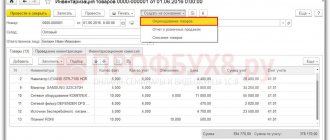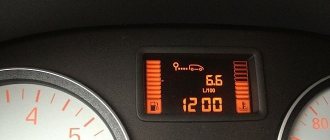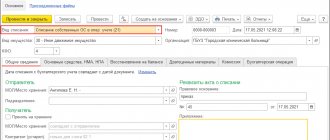Every organization must carry out periodic inspections of material assets and various liabilities, that is, recording the presence and analyzing the condition. The actual quantity, value and condition of tangible assets must correspond to the figures entered in the accounting records. Inventory of property funds, goods, and other assets is an indispensable procedure for all business owners.
In what cases is an inventory carried out ?
We will describe below what rules this operation is carried out and what nuances are typical for its documentation.
Inventory and its objective importance
Periodic accounting of material assets by comparing actual objective information obtained after a personal inspection with the information reflected in accounting is called inventory .
A discrepancy between the actual and documented state or number of inventory assets is possible for a number of reasons:
- natural influences on certain material assets that can affect changes in their quantity, weight, volume, residual value (shrinkage, losses during transportation, spoilage due to storage, evaporation, etc.);
- identification of abuses in the accounting of material resources (incorrect measurements, allowance of body kits, theft, etc.);
- problems that arose when making entries in accounting documentation (slips, errors, blots, corrections, inaccuracies and other ambiguities).
How to reflect inventory results in accounting and tax accounting ?
Therefore, regular inventory taking is of utmost importance for any enterprise.
Check Features
Such a procedure is a means of preserving the organization’s property, as well as controlling the existing array. Therefore, in addition to planned actions, it is often a response to an external factor. The storekeeper quit - we need to check whether this is part of a scam to steal funds. A reorganization took place; most likely, some of the products were greatly affected; they could have been transported or written off. Again you should check that everything is in place.
Due to the different purposes and related tasks, the study location is highlighted. In a general sense, when it comes to annual audits, scheduled audits, reconciliations before filing financial statements, this is general coverage. That is, all inventory items will be strictly taken into account. And if we are talking about the dismissal of a specific responsible person, then the coverage area will be narrower, only the one where this person made decisions and conducted activities. Usually there is a target warehouse or, in extreme cases, several. It is noteworthy that the algorithm for conducting an inventory of inventory items does not change depending on the volume involved. But the documentation may well. It is worth understanding that each object needs registration and its own inventory. The order and general reporting are just the tip of the iceberg. During the process, each object will receive its own documentation.
And all possible documentation options have a strictly prescribed format in legal acts. These are precise forms, where any discrepancy will call into question, in principle, the correctness of the entire procedure as a whole. Although this is often an internal matter of the enterprise, an incorrect format can have a very negative impact. For example, such a document cannot become evidence in court if a legal entity wants to accuse its employee of theft.
Required by law
The mandatory nature of this procedure is approved by the federal legislation of our country. Entrepreneurs are required to regularly take inventory of their own, stored or leased property and their financial obligations by two regulatory documents:
- Federal Law of December 6, 2011 No. 402-FZ “On Accounting”;
- Methodological recommendations for inventory of property and financial obligations (approved by Order of the Ministry of Finance of Russia dated June 13, 1995 No. 49).
How to take inventory during reorganization ?
Reasons for assigning an inventory
In accordance with legislative documents, an inventory must be carried out by organizations, regardless of their form of ownership, in the following circumstances:
- when selling, purchasing or leasing tangible property;
- if the organization is reorganized or officially liquidated;
- when a person bearing financial responsibility changes in a particular area;
- in cases where a municipal organization or state-owned enterprise is transformed into another form of ownership;
- when establishing facts of theft (theft), violation of conditions of storage, movement and release of goods, identification of abuses, etc.;
- after the end of sudden extreme conditions - accidents, natural disasters, catastrophes, and other emergency situations;
- under any circumstances, at least once a year before drawing up the annual accounting report (if the inventory was carried out after October 1 of the current year, this is enough).
FOR YOUR INFORMATION! If financial responsibility is borne not by an individual, but by a group, for example, a brigade, then the reason for the inventory may be a change in the leader of this group (foreman) or more than half of its composition, or a request from any member of the group.
In what cases is a cash register inventory carried out?
There are two types of cash register inventories - planned inventory and unscheduled (sudden) audit of the cash register.
A planned inventory of the cash register is carried out in cases established by regulations; its timing and regulations are approved in advance in the accounting policies and other additional administrative documents of the organization.
So, it is necessary to carry out an inventory of the cash register:
- when transferring the organization’s property for rent, redemption, sale, as well as in cases provided for by law during the transformation of a state or municipal unitary enterprise;
- before preparing annual financial statements;
- when changing financially responsible persons (on the day of acceptance and transfer of cases);
- when establishing facts of theft, abuse, damage to valuables;
- in case of force majeure, in case of natural disasters, fire, accidents or other emergencies;
- during the liquidation (reorganization) of an organization before drawing up a liquidation (separation) balance sheet and in other cases provided for by the legislation of the Russian Federation or regulations of the Ministry of Finance (based on clause 1.5 of Methodological Instructions No. 49).
An unscheduled inventory of the cash register (audit), on the contrary, is carried out suddenly, unexpectedly for the financially responsible person in order to check his integrity and competence. For example, a cash register audit is carried out:
- to strengthen the internal control system at the enterprise;
- identifying the cause of an accounting error;
- at the request of auditors, investigative and control authorities.
The current legislation does not define the timing of a sudden (unscheduled) inventory of the cash register, so organizations and entrepreneurs determine them independently. The order for an unscheduled inventory should indicate the reason for such an inventory of the cash register.
Who sets the procedure?
In addition to the legal requirements set out in the Methodological Recommendations, all other nuances of the inventory remain the responsibility of the organization’s management. Naturally, they must be recorded in the local documentation of the enterprise. The Directorate needs to clarify the following issues:
- how many inventories need to be carried out during the working year;
- at what time should this be done;
- listing the types of assets subject to inspection;
- appointment of the head and members of the inventory commission;
- possibility of selective (sudden) inventory.
What exactly is being checked?
Depending on which assets are included in the inventory list, one or another form is distinguished:
- complete inventory - the entire property fund corresponding to the company’s property rights, material assets leased and/or taken for safekeeping, plus possible unaccounted for assets and business liabilities;
- selective (sudden) inventory - a specified share of property is subject to re-registration (for example, only assets under the control of a specific person bearing financial responsibility, or those combined geographically).
The following groups of material assets and commercial obligations are recognized as inventory objects in one or another combination.
- Fixed assets of the company.
- Goods.
- Intangible property.
- Cash investments.
- Unfinished production.
- Planned expenses.
- Cash, valuable documents, strict reporting forms.
- Calculations.
- Reserves.
- Animals, plants, seed, etc. (in the relevant field of entrepreneurship).
Body carrying out inspection and accounting
Since inventory is recognized by law as a mandatory and regular action, it is advisable to have a permanent inventory commission at the enterprise, which has the following responsibilities:
- preventive measures aimed at preserving material assets;
- participation in resolving problems related to the management of storage issues and possible damage to property funds;
- control of documentary support of the dynamics of material assets;
- ensuring the inventory process in all its aspects (instructing commission members, carrying out the inspection itself, preparing relevant documentation);
- registration of inventory results.
The composition of the commission is approved by the management of the organization, registered in accordance with the order and recorded in the Logbook for monitoring the implementation of orders (decrees, instructions) to conduct an inventory (form No. INV-23). It can include:
- administrative workers;
- accounting employees;
- internal auditors or independent experts;
- representatives of any specialty working at the enterprise.
If the volume of property assets is small, then the function of the inventory commission can be assigned to the audit commission in cases where it operates at the enterprise.
IMPORTANT! If during the actual inspection the absence of even one member of the commission is recorded, then the inventory is not considered valid.
Inventory procedure
As part of the inventory in the store and in the warehouse, in fact, you need to count and evaluate the goods in stock, fill out an inventory list, in case of any problems - in terms of quality or quantity - draw up the appropriate acts, and then transfer the compiled inventory and acts to accounting. There, based on them, a comparison sheet will be drawn up, which reflects the inventory results for each product. At the last step, a results record sheet is drawn up, containing generalized results. Then an order (instruction) is issued to approve the inventory results and changes are made to the accounting. Then a decision is made to recover damages from financially responsible persons.
The process is quite complicated, especially for beginners, so we have developed a table that will clearly tell you how to take inventory.
| Stage | Actions | Document (form) |
| Preparing for inventory and collecting commission | The director issues an order and creates a commission, which includes a financially responsible person and an accountant, if any. If not, then only yourself, but in different functional roles. | INV-22 - Order to conduct an inventory. |
| Carrying out an inventory and recording its results | An inventory list is printed, and members of the commission recalculate the remaining goods. The data is entered in the “Actual Availability” column. Upon completion of the recount, the document is signed by all members of the commission. | INV-3 - inventory list of goods and materials. |
| Reconciliation of the actual inventory result with accounting data | A matching statement is generated. Acts and other documents are filled out that explain the discrepancies between actual data and accounting data. If you have an accountant, he carries out the reconciliation based on the INV-3 inventory list. | INV-19 - a comparison statement of the results of the inventory of inventory items. INV-6 is an act of inventory of goods and materials in transit. INV-5 - inventory list of goods and materials accepted for safekeeping. TORG-16 - act on write-off of goods. |
| Summing up the inventory results and reflecting them in accounting | A decision is made to recover damages from those responsible. The manager issues an order approving the inventory results - on its basis, entries are made in accounting. At the same time, a statement of inventory results is compiled. | Order (instruction) on approval of inventory results. INV-26 - Statement of records of results identified by inventory. |
Below we will talk in more detail about the stages indicated in the table.
Preparing for inventory and collecting commission
Inventory in a store or warehouse begins with the issuance of an order to conduct an inventory in the INV-22 form, which must be signed by the manager or owner of the outlet. Next, it is necessary to create a special commission, which must include an accountant and a financially responsible person, for example, a seller or warehouse worker.
Let's take a closer look at how to properly conduct an inventory. In trade organizations, according to the law, this process begins suddenly for sellers and storekeepers - workers should not know anything before the commission comes to the store or warehouse. After this, the sale and movement of goods that fall under inventory are prohibited. That is, either it is necessary to close the entire warehouse or store, or only the department being checked and the cash register at the department. Inventory of a warehouse and a retail outlet differ in that it is much more difficult to count the goods in the warehouse than on the shelves, so it takes more time and effort.
Preparation for the recount of goods must be carried out in the presence of all members of the commission. To simplify the process in a large store, you can draw up an inventory plan, for example, according to a product location diagram. In this case, after recalculation, you can directly record the actual quantity of products on it. This method is convenient due to its clarity.
Carrying out an inventory and recording its results
When taking inventory, the commission checks not only the quantity of goods, but also its quality, shelf life and expiration date. To record the results, a document must be generated - an inventory of the actual availability of valuables in the INV-3 form, which lists all goods by group, indicating the variety, article number and other characteristics that increase the accuracy of accounting. Depending on the types of products presented in the store and lying in the warehouse, in addition to recalculation, the procedure includes control weighing, measurement, and others.
If the accounting processes in your organization are automated, then the verification is faster - the remaining goods are printed from the system and checked against what is on the shelves and in the warehouse. This way you can quickly detect shortages or surpluses during inventory. MyWarehouse is perfect for this - a convenient accounting system that will help speed up verification as much as possible.
The inventories must be drawn up in two copies: on the basis of one, the accountant will draw up a matching statement, the second will be received by the financially responsible person. If the inventory is compiled manually, then blots are not allowed in it. Incorrect data is crossed out with one line, and the correct numbers are placed above them.
Corrections in documents when conducting an inventory and recording its results must be agreed upon with all members of the commission and financially responsible persons and certified by their signature.
During the audit, values that are not reflected in the accounting may also be discovered. These surpluses also need to be included in the inventory.
Reconciliation of actual data with accounting data
Based on the results of the audit, it is necessary to transfer the inventory completed and signed by all members of the commission to the accounting department. There will be a reconciliation of the actual balances of goods from the inventories with the data of the accounting system. If there is no accounting department, then the duties of the accountant are performed by the general director, and the reconciliation must be carried out by him. If deviations in actual availability were identified in a store or warehouse, this must be reflected in the comparison sheet of the inventory results of inventory items in the INV-19 form. It must be signed by the financially responsible person.
If goods are in transit, stored at a location other than the inventory location, or are damaged, then the following documents are drawn up:
- INV-6 - act of inventory of goods and materials in transit;
- INV-5 - inventory list of goods and materials accepted for safekeeping;
- TORG-15 - act of damage, combat;
- TORG-16 - act on write-off of goods.
Sometimes, during the inspection, some goods have not yet been delivered to the store - in this case, you need to fill out the INV-6 act form. Products that are stored in warehouses of other organizations are indicated in the INV-5 form.
For spoiled goods that are not subject to further sale, including due to their expiration date, a write-off report is drawn up in the TORG-16 form. It is filled out in three copies: for the financially responsible person, the accounting department and the department where the inventory is carried out. All members of the commission must sign it. In case of damage, damage, or scrap of goods, TORG-15 is filled out - for goods that can be discounted or written off. The document must be executed in triplicate, according to the head of the organization.
Download documents for inventory!
Register in the MoySklad online service, where you can:
- Download blank forms and completed samples INV-22, INV-3, INV-5, INV-6, INV-19, INV-26, TORG-16
- Fill out and print documents online (it’s very convenient)
- Keep records of goods, register sales and conduct inventories directly from your mobile phone
Summing up the inventory results and reflecting them in accounting
At this stage, when there is a clear picture of deviations, the manager issues an order to approve the inventory results. On its basis, it is possible to recover damages from the perpetrators and make appropriate entries in accounting.
In parallel with this, in the INV-26 results sheet, the accountant enters all the final figures in the columns: surpluses, shortages, damaged goods, records misgrading, distributes in columns the amounts of natural loss, the amount that needs to be written off from the guilty parties and the amount in excess of the norms of natural loss. The document is signed by all participants in the process. After this, the owner or accounting department has legal grounds to recover damages from the guilty parties. The inventory process has been documented completed.









